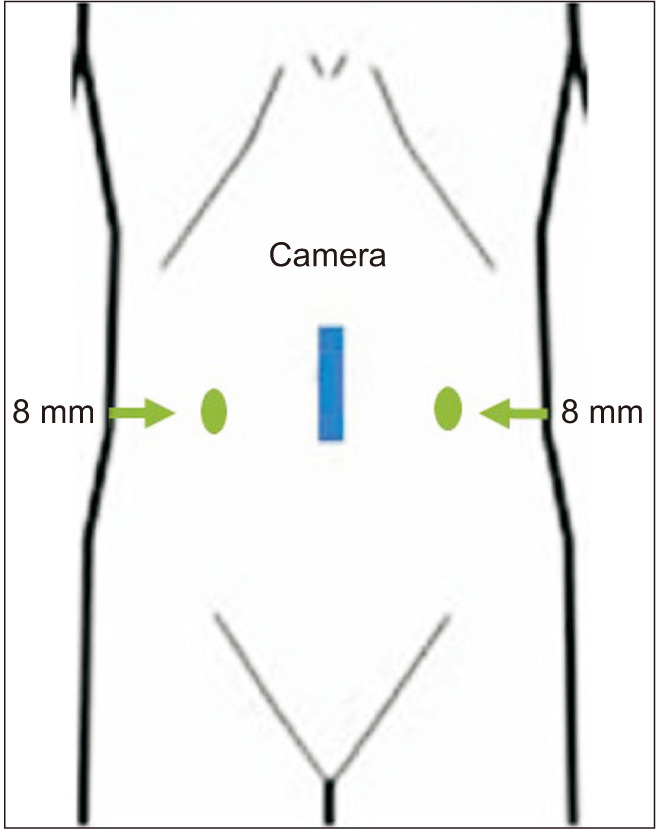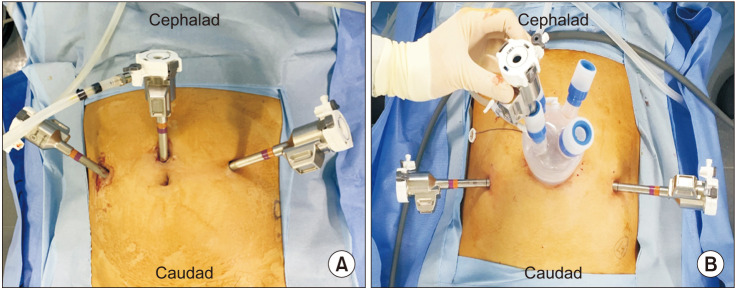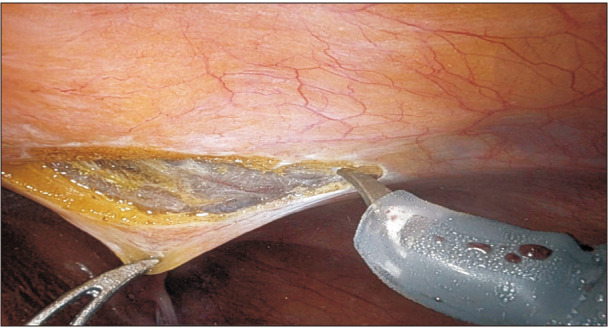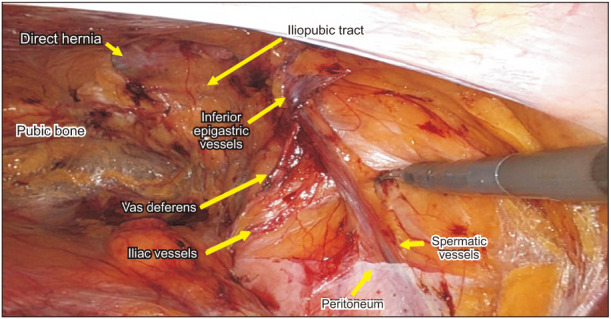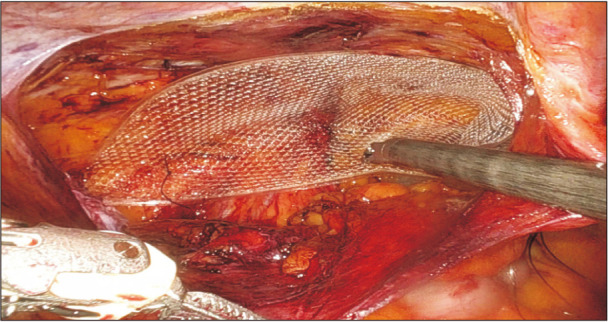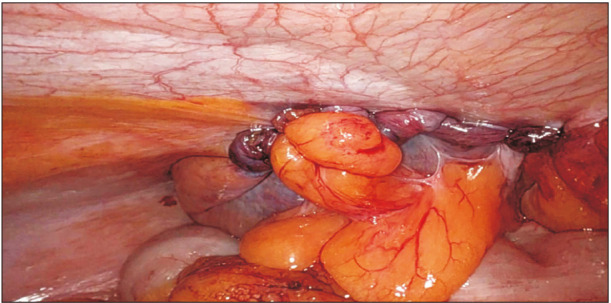Ann Surg Treat Res.
2023 Mar;104(3):176-181. 10.4174/astr.2023.104.3.176.
One-year experience of robotic transabdominal preperitoneal approach in a single institute: 2 different surgeons with different levels of experience
- Affiliations
-
- 1Division of Colorectal Surgery, Department of Surgery, The Catholic University of Korea, St. Vincent Hospital, Suwon, Korea
- KMID: 2539697
- DOI: http://doi.org/10.4174/astr.2023.104.3.176
Abstract
- Purpose
The robotic platform, an extension of minimally invasive procedures, is distributed nationwide and readily available. However, its application in inguinal hernia repair seems rare in Korea. This report aims to share our initial experience with robotic inguinal hernia repair.
Methods
The patients who underwent robotic inguinal hernia repair by 2 different surgeons with different experiences at a single center were retrospectively analyzed. The surgical procedures were performed on all patients using the Da Vinci Xi robotic platform (Intuitive Surgical Inc). Patient demographics, operation variables, and postoperative outcomes were analyzed.
Results
A total of 35 patients underwent robotic inguinal hernia repairs consecutively. The mean age was 55.03 ± 18.20 years. The majority of patients were male. The overall mean operation time was 103.98 ± 47.92 minutes for unilateral hernia surgery and 139.28 ± 46.07 minutes for bilateral surgery. None of the patients experienced intraoperative complications. However, postoperative complications were noticed in 8 patients: 3 with seroma formation, 1 with hematoma, 1 with superficial surgical site infection, and 3 with persistent pain at the operation site.
Conclusion
This report demonstrates an early experience of hernia surgery using the robotic platform. The robotic approach for transabdominal preperitoneal hernia repair was completed without any significant intraoperative or postoperative complications. It may be a viable option as a minimally invasive technique. Cost-effectiveness, optimal procedural steps, and indications for the robotic approach remain to be further investigated.
Keyword
Figure
Reference
-
1. Kingsnorth A, LeBlanc K. Hernias: inguinal and incisional. Lancet. 2003; 362:1561–1571. PMID: 14615114.2. Han SR, Kim HJ, Kim NH, Shin S, Yoo RN, Kim G, et al. Inguinal hernia surgery in Korea: nationwide data from 2007-2015. Ann Surg Treat Res. 2019; 97:41–47. PMID: 31297352.3. Trevisonno M, Kaneva P, Watanabe Y, Fried GM, Feldman LS, Lebedeva E, et al. A survey of general surgeons regarding laparoscopic inguinal hernia repair: practice patterns, barriers, and educational needs. Hernia. 2015; 19:719–724. PMID: 25079224.4. Ger R, Monroe K, Duvivier R, Mishrick A. Management of indirect inguinal hernias by laparoscopic closure of the neck of the sac. Am J Surg. 1990; 159:370–373. PMID: 2138432.5. Sheetz KH, Claflin J, Dimick JB. Trends in the adoption of robotic surgery for common surgical procedures. JAMA Netw Open. 2020; 3:e1918911. PMID: 31922557.6. Simons MP, Aufenacker T, Bay-Nielsen M, Bouillot JL, Campanelli G, Conze J, et al. European Hernia Society guidelines on the treatment of inguinal hernia in adult patients. Hernia. 2009; 13:343–403. PMID: 19636493.7. Leijte E, de Blaauw I, Van Workum F, Rosman C, Botden S. Robot assisted versus laparoscopic suturing learning curve in a simulated setting. Surg Endosc. 2020; 34:3679–3689. PMID: 31754849.8. Kudsi OY, McCarty JC, Paluvoi N, Mabardy AS. Transition from laparoscopic totally extraperitoneal inguinal hernia repair to robotic transabdominal preperitoneal inguinal hernia repair: a retrospective review of a single surgeon’s experience. World J Surg. 2017; 41:2251–2257. PMID: 28337532.9. Escobar Dominguez JE, Ramos MG, Seetharamaiah R, Donkor C, Rabaza J, Gonzalez A. Feasibility of robotic inguinal hernia repair, a single-institution experience. Surg Endosc. 2016; 30:4042–4048. PMID: 26718359.10. Dewulf M, Aspeslagh L, Nachtergaele F, Pletinckx P, Muysoms F. Robotic-assisted laparoscopic inguinal hernia repair after previous transabdominal prostatectomy. Surg Endosc. 2022; 36:2105–2112. PMID: 33796906.11. Prabhu AS, Carbonell A, Hope W, Warren J, Higgins R, Jacob B, et al. Robotic inguinal vs transabdominal laparoscopic inguinal hernia repair: the RIVAL randomized clinical trial. JAMA Surg. 2020; 155:380–387. PMID: 32186683.
- Full Text Links
- Actions
-
Cited
- CITED
-
- Close
- Share
- Similar articles
-
- Robotic transabdominal preperitoneal repair for bilateral obturator hernia: a video vignette
- Early outcomes of robotic transabdominal preperitoneal inguinal hernia repair: a retrospective single-institution study in Korea
- Robotic Radical Nephrectomy with Vena Caval Tumor Thrombectomy: Experience of Novice Robotic Surgeons
- Left Side Approach in Laparoscopic Transabdominal Preperitoneal Inguinal Herniorrhaphy is Feasible for Any Type of Inguinal Hernia
- Orchidopexy: a 10-year Clinical Experience

